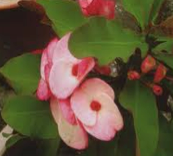Sesudu
| Sesudu | |
| Scientific Name | Euphorbia neriifolia (L) A. Chev |
| Family | Euphorbiaceae |
| Division | Magnoliophyta |
| Class | Magnolipsida |
| Subclass | Eurosid 1 |
| Order | Malpighiales |
| Subfamily | Euphobioideae |
| Common Names | Indian spurge tree (English), sesudu (Malay), Soro-soro (Tag) |
| Synonym | Euphobia ligularia Roxb. Ex Buch.-Ham, Tithymalus edulis (Lour.) H. Karst |
| Description | Neriifolia means “leaves like an oleander”. Herb full of spine |
 |
{slider= Geographical & Distribution}
Native Asia Tropical Malaysia, New Guinea, Myanmar and India. Asia temperate-China
{/slider}
{slider=General Appearance}
Shrubby, erect, baranched, fleshy, cactus like plant, 2 to 4 meter high, the trunk and older branches being grayish and cylinder. The leaves arise from the sides of wings towards the end of the brances, are fleshy, oblong-obviate, 5 to 15 centimeters long, or in young plants somewhat longer, painted or blunt at the tip. (Patil S.B. & Magdum C.S. 2012).
{/slider}
{slider=Purity Test}
Moisture : Leaf 73.8%, Stem 62.4%, Bark 86.9% Whole plant 78.6. Oil: Leaf 2.46%, Stem: 3.56%, Bark 4.95%, Whole plant 3.87%, Polyphenol : leaf 4.67%, Stem 9.63% Bark 12.68% Whole plant 11.49%, Hydrocarbon: leaf 0.42%, Stem 2.58%, Bark 2.93, Whole plant 2.28% (Kalitha, 2004)
{/slider}
{slider=Traditional Uses}
Leaves are used as aphrodisiac, diuretic, cough and cold, and used in treatment of bronchitis, bleeding piles, ano-rectal fistula (Ahmaed, S.A. et al , 2011).
{/slider}
{slider=Major Chemical Constituents}
Triterpenes (nerrifolione), flavonoids and steroidal saponins, sugar tannins, flavonoids, alkaloids and triterpenoidal saponin
{/slider}
{slider=Medicinal Use}
Diuretic effects
Leaf extract give more significant diuretic effects than diuspec (Quero et al 2008).
Anti fungal
The crude leaves extracts were anti fungal property to Aspergillus spp, the Aspegillus and Aspergillus niger (Sampaga D.A. & Mariano C., 2013). Abstract in 7th annual celebration of the Philippine National Health Research System Week
The ethanolic extract of E. nerrifolia was showing potent inhibitory activity of enzyme aniline hydroxylase (Patil, S.B & C.S. Magdum, 2012). E. nerrifolia L concentration required for 50% inhibition of aniline hydroxylase was 481.85 μg/ml which was less potent then the E. hirta extracts.
Methanolic extract of leaves of E. nerrifolia Linn a were have effects against Indian worm Pheretima posthuma (Ghodake, R.S. et al, 2011).
Mortality rates of Mithima searate larvae with E. neriifolia latex is 32.99 % (Chandrica S. et al, 2012).
The hepatoprotective effect of saponin fraction isolated from leaf of E. nerrifolia on CCl4-induced hepatoxicity on rat. Hydro-alcoholic extract of dried leaves E.neriifolia in treatment of inflammation and analgesic activity (Bigoniya P. et al 2010)
P. Bigoniya & A.C. Rana et al found out the effect of sub-acute administration of Euphorbia neriifolia leaf extract on some haematoligical, biochemical, histological, biochemical, histological and antioxidant enzyme status of rat liver and kidney following 21 and 45 days treatment.
The hydroalcoholic extract of E. neriifolia possessing significant protection against E.coli induced abdominal sepsis, significant increase in total leucyte count, differential leucocyte count and phagocytic index was determined.
The expressed juice of the leaves is reported as very effectual in relieving the paroxyms of spasmodic asthma. The leaves are considered diuretic. (Patil S.B. & Magdum C.S. 2012).
E. nerrifolia (aqueous extract) when applied topically facilated the healing of surgically produced cuteneous wounds in guinea pigs. It has increased the gain in tensile strength, DNA content and promoted epithelization (Rasik AM. et al, 1996. Indian J. Pharmacol. 28:107-109.
{/slider}
{slider=Reference}
Ahmed S.A., S. Nazim, S. Siraj, P. M Siddik, Wahid C.A. (2011) Euphorbia neriifolia Linn: A Phytopharmacological Review. International Research Jounal of Pharmacy http://www.irjponline.com.
Bigoniya P., A. Shukla, C. S. Singh (2010). Dermal irritation and sensitization study of Euphorbia neriifolia latex and its anti-inflammatory efficacy. International Journal of Phytomedicine Vol 2(3) http://www.arjournals.org/index.php/ijpm/article/view/114
Chandrica S., P. Devendra, S. Sandeep (2012). Pesticidal Effects of Euphorbia, Nerium and Calotropis Latex on Some Larvae of Crop Damagining Pests. International Journal of Pharmacy & Pharmaceutical Science. Vol 4, p256-260.
Ghodake R.S. Patole N.S, Patil S.B Naikwade N.S., Magdum C.S. (2011). In vitro Anthelmintic Activity of Medicinal Plants against Phretima posthuma. Research Journal of Pharmacology and Pharmacodynamics Vol. 3 Issue 3 pg 112-114.
Kalita D. & Saikia CN. (2004). Chemical constituents and energy content of some latex bearing plants. Biosensour Technol 2004, 92(3):219-227. http://www.ncbi.nlm.nih.gov/pubmed/14766154
Quero R.A., Guzman K.L., Vergara A.S. Effcetively of Soro-soro (Euphorbia nerrifolia) leaf extracts as diuretics. http://region3.dost.gov.ph/index.php?
Patil S. B. & C. S. Magdum (2012). The inhibitory effect of some Indian Plant Extracts on the aniline Hydrolase. Asian Journal of Pharmaceutical and Clinical Research Vol. 5 Suppl 2.
Rasik AM., Shukla A., Patnaik GK.(1996). Indian J. Pharmacol. 28:107-109.
Sampaga D.A. & Mariano C.(2013). Abstract in 7 th annual celebration of the Philippine National Health Research System Week. http://region3.dost.gov.ph/
{/slider}
- Last updated on .
- Hits: 1263
